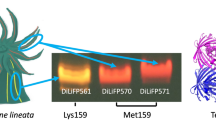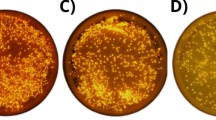Abstract
Green fluorescent protein (GFP)-like proteins have been studied with the aim of developing fluorescent proteins. Since the property of color variation is understudied, we isolated a novel GFP-like chromoprotein from the carpet anemone Stichodactyla haddoni, termed shCP. Its maximum absorption wavelength peak (λ max) is located at 574 nm, resulting in a purple color. The shCP protein consists of 227 amino acids (aa), sharing 96 % identity with the GFP-like chromoprotein of Heteractis crispa. We mutated aa residues to examine any alteration in color. When E63, the first aa of the chromophore, was replaced by serine (E63S), the λ max of the mutated protein shCP-E63S was shifted to 560 nm and exhibited a pink color. When Q39, T194, and I196, which reside in the surrounding 5 Å of the chromophore’s microenvironment, were mutated, we found that (1) the λ max of the mutated protein shCP-Q39S was shifted to 518 nm and exhibited a red color, (2) shCP-T194I exhibited a purple-blue color, and (3) an additional mutation at I196H of the mutated protein shCP-E63L exhibited green fluorescence. In contrast, when the aa located neither at the chromophore nor within its microenvironment were mutated, the resultant proteins shCP-L122H, -E138G, -S137D, -T95I, -D129N, -T194V, -E138Q, -G75E, -I183V, and -I70V never altered their purple color, suggesting that mutations at the shCP chromophore and the surrounding 5 Å microenvironment mostly control changes in color expression or cause fluorescence to develop. Additionally, we found that the cDNAs of shCP and its mutated varieties are faithfully and stably expressed both in Escherichia coli and zebrafish embryos.








Similar content being viewed by others
References
Alieva NO, Konzen KA, Field SF, Meleshkevitch EA, Hunt ME, Beltran-Ramirez V, Miller DJ, Wiedenmann J, Salih A, Matz MV (2008) Diversity and evolution of coral fluorescent proteins. PLoS One 3:e2680
Ando R, Hama H, Yamamoto-Hino M, Mizuno H, Miyawaki A (2002) An optical marker based on the UV-induced green-to-red photoconversion of a fluorescent protein. Proc Natl Acad Sci U S A 99:12651–12656
Artimo P, Jonnalagedda M, Arnold K, Baratin D, Csardi G, de Castro E, Duvaud S, Flegel V, Fortier A, Gasteiger E, Grosdidier A, Hernandez C, Ioannidis V, Kuznetsov D, Liechti R, Moretti S, Mostaguir K, Redaschi N, Rossier G, Xenarios I, Stockinger H (2012) ExPASy: SIB bioinformatics resource portal. Nucleic Acids Res 40:W597–W603
Bulina ME, Chudakov DM, Mudrik NN, Lukyanov KA (2002) Interconversion of Anthozoa GFP-like fluorescent and non-fluorescent proteins by mutagenesis. BMC Biochem 3:7
Chalfie M, Tu Y, Euskirchen G, Ward WW, Prasher DC (1994) Green fluorescent protein as a marker for gene expression. Science 263:802–805
Chan MCY, Karasawa S, Mizuno H, Bosanac I, Ho D, Prive GG, Miyawaki A, Ikura M (2006) Structural characterization of a blue chromoprotein and its yellow mutant from the sea anemone Cnidopus japonicus. J Biol Chem 281:37813–37819
Chen CC, Hwang JK, Yang JM (2006) (PS)2: protein structure prediction server. Nucleic Acids Res 34:W152–W157
Chou CY, Horng LS, Tsai HJ (2001) Uniform GFP-expression in transgenic medaka (Oryzias latipes) at the F0 generation. Transgenic Res 10:303–315
Chudakov DM, Feofanov AV, Mudriku NN, Lukyanov S, Lukyanov KA (2003) Chromophore environment provides clue to “kindling fluorescent protein” riddle. J Biol Chem 278:7215–7219
Cubitt AB, Heim R, Adams SR, Boyd AE, Gross LA, Tsien RY (1995) Understanding, improving and using green fluorescent proteins. Trends Biochem Sci 20:448–455
Dove SG, Takabayashi M, HoeghGuldberg O (1995) Isolation and partial characterization of the pink and blue pigments of pocilloporid and acroporid corals. Biol Bull 189:288–297
Gurskaya NG, Fradkov AF, Terskikh A, Matz MV, Labas YA, Martynov VI, Yanushevich YG, Lukyanov KA, Lukyanov SA (2001) GFP-like chromoproteins as a source of far-red fluorescent proteins. FEBS Lett 507:16–20
Heim R, Prasher DC, Tsien RY (1994) Wavelength mutations and posttranslational autoxidation of green fluorescent protein. Proc Natl Acad Sci U S A 91:12501–12504
Heim R, Cubitt AB, Tsien RY (1995) Improved green fluorescence. Nature 373:663–664
Inouye S, Tsuji FI (1994) Aequorea green fluorescent protein. Expression of the gene and fluorescence characteristics of the recombinant protein. FEBS Lett 341:277–280
Labas YA, Gurskaya NG, Yanushevich YG, Fradkov AF, Lukyanov KA, Lukyanov SA, Matz MV (2002) Diversity and evolution of the green fluorescent protein family. Proc Natl Acad Sci U S A 99:4256–4261
Lin CY, Yung RF, Lee HC, Chen WT, Chen YH, Tsai HJ (2006) Myogenic regulatory factors Myf5 and Myod function distinctly during craniofacial myogenesis of zebrafish. Dev Biol 299:594–608
Lukyanov KA, Fradkov AF, Gurskaya NG, Matz MV, Labas YA, Savitsky AP, Markelov ML, Zaraisky AG, Zhao XN, Fang Y, Tan WY, Lukyanov SA (2000) Natural animal coloration can be determined by a nonfluorescent green fluorescent protein homolog. J Biol Chem 275:25879–25882
Matz MV, Fradkov AF, Labas YA, Savitsky AP, Zaraisky AG, Markelov ML, Lukyanov SA (1999) Fluorescent proteins from nonbioluminescent Anthozoa species. Nat Biotechnol 17:969–973
Mizuno H, Mal TK, Tong KI, Ando R, Furuta T, Ikura M, Miyawaki A (2003) Photo-induced peptide cleavage in the green-to-red conversion of a fluorescent protein. Mol Cell 12:1051–1058
Niwa H, Inouye S, Hirano T, Matsuno T, Kojima S, Kubota M, Ohashi M, Tsuji FI (1996) Chemical nature of the light emitter of the Aequorea green fluorescent protein. Proc Natl Acad Sci U S A 93:13617–13622
Pakhomov AA, Pletneva NV, Balashova TA, Martynov VI (2006) Structure and reactivity of the chromophore of a GFP-like chromoprotein from Condylactis gigantea. Biochemistry 45:7256–7264
Pletnev VZ, Pletneva NV, Lukyanov KA, Souslova EA, Fradkov AF, Chudakov DM, Chepurnykh T, Yampolsky IV, Wlodawer A, Dauter Z, Pletnev S (2013) Structure of the red fluorescent protein from a lancelet (Branchiostoma lanceolatum): a novel GYG chromophore covalently bound to a nearby tyrosine. Acta Crystallogr D Biol Crystallogr 69:1850–1860
Shaner NC, Patterson GH, Davidson MW (2007) Advances in fluorescent protein technology. J Cell Sci 120:4247–4260
Shkrob MA, Yanushevich YG, Chudakov DM, Gurskaya NG, Labas YA, Poponov SY, Mudrik NN, Lukyanov S, Lukyanov KA (2005) Far-red fluorescent proteins evolved from a blue chromoprotein from Actinia equina. Biochem J 392:649–654
Subach FV, Subach OM, Gundorov IS, Morozova KS, Piatkevich KD, Cuervo AM, Verkhusha VV (2009) Monomeric fluorescent timers that change color from blue to red report on cellular trafficking. Nat Chem Biol 5:118–126
Verkhusha VV, Lukyanov KA (2004) The molecular properties and applications of Anthozoa fluorescent proteins and chromoproteins. Nat Biotechnol 22:289–296
Verkhusha VV, Chudakov DM, Gurskaya NG, Lukyanov S, Lukyanov KA (2004) Common pathway for the red chromophore formation in fluorescent proteins and chromoproteins. Chem Biol 11:845–854
Wall MA, Socolich M, Ranganathan R (2000) The structural basis for red fluorescence in the tetrameric GFP homolog DsRed. Nat Struct Biol 7:1133–1138
Wilmann PG, Petersen J, Pettikiriarachchi A, Buckle AM, Smith SC, Olsen S, Perugini MA, Devenish RJ, Prescott M, Rossjohn J (2005) The 2.1A crystal structure of the far-red fluorescent protein HcRed: inherent conformational flexibility of the chromophore. J Mol Biol 349:223–237
Acknowledgments
We thank the NTU Center of Genomic Medicine for providing the LC-MS/MS service. We also thank TC3 Proteomics, Technology Commons, College of Life Science, NTU, for providing the protein analysis tools. This work was supported by the Council of Agriculture, Executive Yuan, Taiwan, R.O.C., under grant 102AS-11.3.3-FA-F3.
Author information
Authors and Affiliations
Corresponding author
Rights and permissions
About this article
Cite this article
Chiang, CY., Chen, YL. & Tsai, HJ. Different Visible Colors and Green Fluorescence Were Obtained from the Mutated Purple Chromoprotein Isolated from Sea Anemone. Mar Biotechnol 16, 436–446 (2014). https://doi.org/10.1007/s10126-014-9563-2
Received:
Accepted:
Published:
Issue Date:
DOI: https://doi.org/10.1007/s10126-014-9563-2




